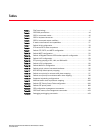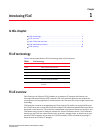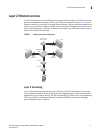
2 Dell Converged Enhanced Ethernet Administrator’s Guide
53-1002116-01
FCoE overview
1
The motivation behind using CEE networks as a transport mechanism for FC arises from the desire
to simplify host protocol stacks and consolidate network interfaces in data center environments. FC
standards allow for building highly reliable, high-performance fabrics for shared storage, and these
characteristics are what CEE brings to data centers. Therefore, it is logical to consider transporting
FC protocols over a reliable CEE network in such a way that it is completely transparent to the
applications. The underlying CEE fabric is highly reliable and high performing, the same as the FC
SAN.
In FCoE, ENodes discover FCFs and initialize the FCoE connection through the FCoE Initialization
Protocol (FIP). The FIP has a separate EtherType from FCoE. The FIP includes a discovery phase in
which ENodes solicit FCFs, and FCFs respond to the solicitations with advertisements of their own.
At this point, the ENodes know enough about the FCFs to log into them. The fabric login and fabric
discovery (FLOGI/FDISC) for VN-to-VF port connections is also part of the FIP.
NOTE
With pre-FIP implementations, as an alternative to FIP, directly connected devices can send an
FCoE-encapsulated FLOGI to the connected FCF.
FCoE hardware
At a fundamental level, FCoE is designed to enable the transport of storage and networking traffic
over the same physical link. Utilizing this technology, Dell FCoE hardware provides a unique
platform that connects servers to both LAN and SAN environments.
Within this manual, any appearance of the term “Dell FCoE hardware” refers to any of Dell’s FCoE
products.
NOTE
The intermediate switching devices in the CEE network do not have to be FCoE-aware. They simply
route the FCoE traffic to the FCoE device based on the Ethernet destination address in the FCoE
frame.


















